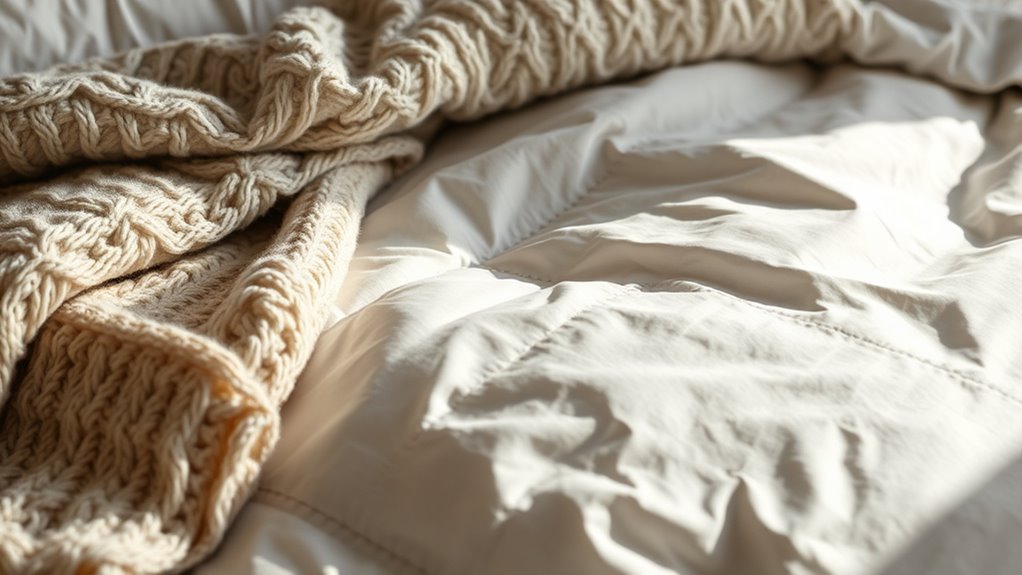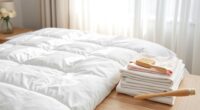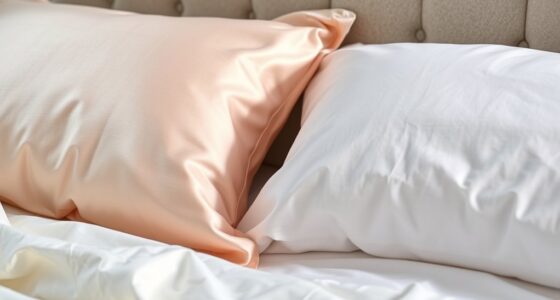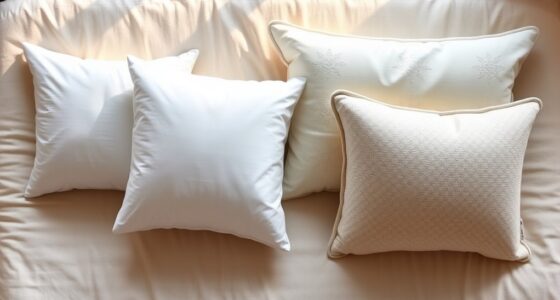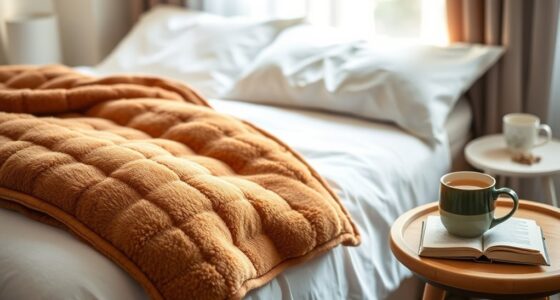Blankets, comforters, and duvets differ mainly in materials, construction, and purpose. Blankets are simple coverings usually made of wool or cotton, offering versatile warmth. Comforters are quilted with evenly distributed filling for consistent cozy feel, while duvets are lightweight and come with removable covers for seasonal flexibility. Comforters and duvets often require more specific care, and their durability depends on construction quality. To understand how each best suits your needs, keep exploring the details.
Key Takeaways
- Blankets are lightweight coverings suitable for layering, while comforters are pre-filled, quilted bedding for consistent warmth, and duvets are removable-filled covers for versatility.
- Comforters are typically thicker and warmer than blankets, which are more adaptable for various temperatures.
- Duvets require separate covers that can be changed for style or season, unlike comforters and blankets.
- Construction quality impacts durability; well-stitched comforters and duvets last longer than simple blankets.
- Maintenance varies; blankets often need frequent washing, whereas comforters and duvets require gentle care and proper storage.
Materials and Construction
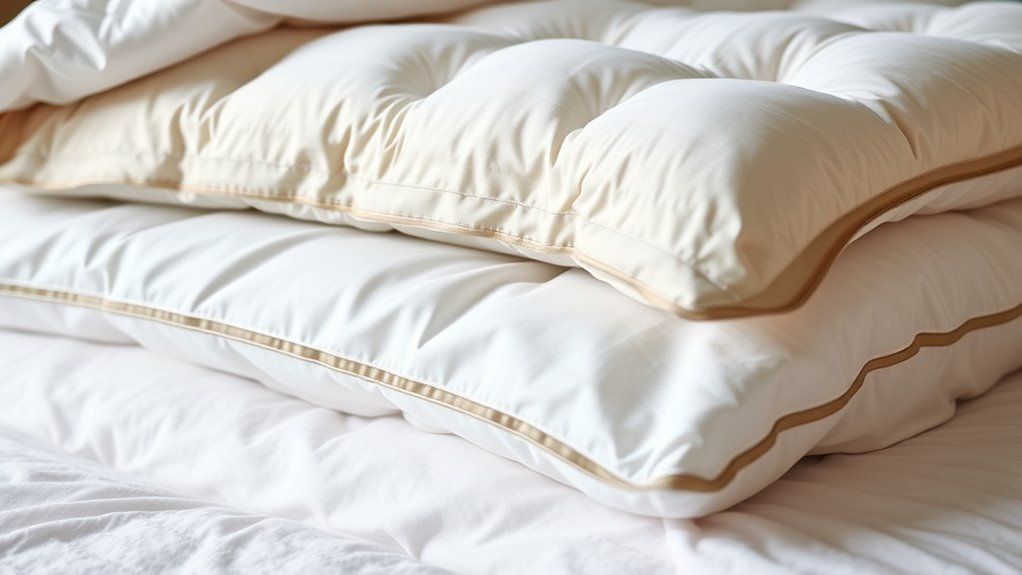
When it comes to materials and construction, blankets, comforters, and duvets each have distinct characteristics that affect their warmth and durability. Fabric types vary widely, from soft cotton and cozy wool to synthetic blends, influencing comfort and maintenance. Comforters and duvets often feature quilting or box-stitching techniques that keep the filling evenly distributed, preventing clumping and ensuring consistent warmth. Blankets, on the other hand, may use simple stitching or no stitching at all, depending on the design. The choice of stitching techniques directly impacts the longevity of each item, as well-constructed seams prevent shifting of filling and improve durability. Additionally, the construction quality of these bedding items plays a crucial role in their ability to withstand regular use and washing, ensuring they remain functional and attractive over time. Understanding these differences helps you select the right bedding based on your preference for warmth, feel, and long-term use.
Usage and Functionality
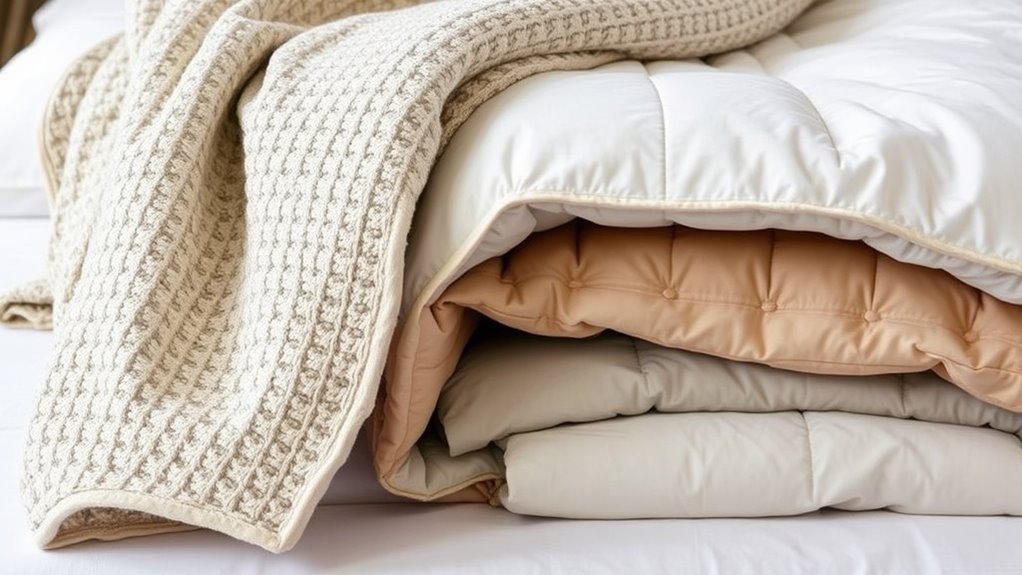
The materials and construction of blankets, comforters, and duvets directly influence how you use them day to day. Your choice affects weight and warmth, as well as versatility and layering options. For instance, heavier blankets provide immediate warmth, ideal for cold nights, while lightweight duvets can be layered for adjustable comfort. Comforters often come in pre-filled designs, offering consistent warmth without layering. Duvets, with removable covers, let you easily switch styles and add or remove fillings for different seasons. Here’s a quick comparison:
| Feature | Blankets | Comforters | Duvets |
|---|---|---|---|
| Weight & Warmth | Varies, layered options | Consistent, moderate to heavy | Customizable, adaptable |
| Versatility | High, easy to layer | Moderate, fixed design | Very high, cover change |
| Usage | Bed, throw, travel | Bed, decorative | Bed, seasonal adjustments |
Additionally, the ability to change duvet covers makes duvets a versatile bedding option for frequent style updates.
Maintenance and Care
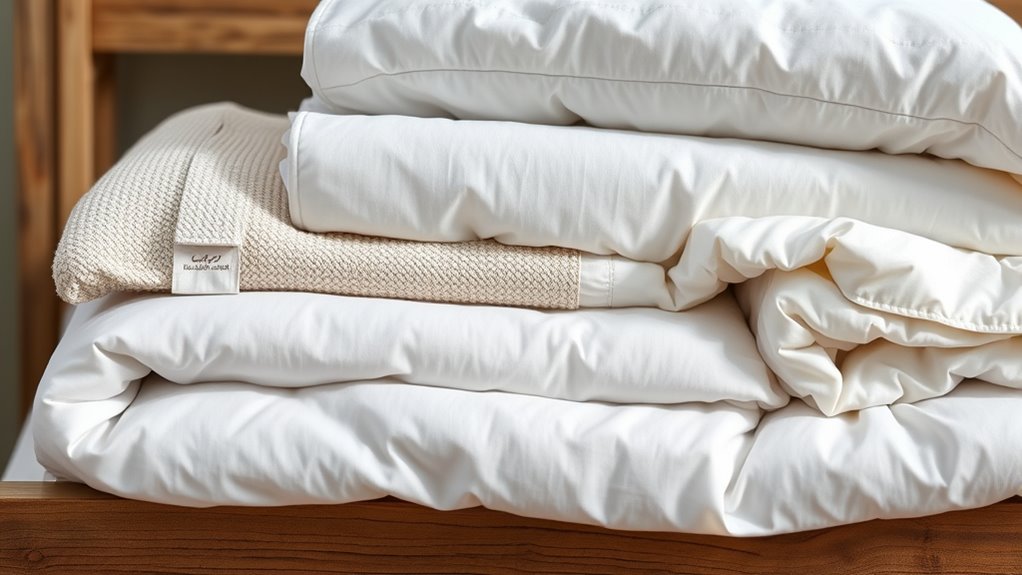
Maintaining blankets, comforters, and duvets requires understanding their specific care needs to keep them fresh and functional. Proper washing instructions help prevent damage and maintain their fluffiness. Here are four key tips:
- Follow the manufacturer’s washing instructions carefully to avoid shrinking or fabric damage.
- Use gentle cycles and mild detergents for comforters and duvets; blankets may need more frequent washing.
- Air out or shake your bedding regularly to keep it fresh between washes.
- Store seasonally when not in use by keeping them in breathable bags or containers, avoiding plastic which traps moisture.
- Regular maintenance also includes inspecting for any signs of wear or damage, especially with luxurious water park hotels, ensuring your bedding remains inviting and in top condition.
Proper seasonal storage prevents mold and odors, extending the lifespan of your bedding. Regular maintenance guarantees your blankets, comforters, and duvets stay comfortable and inviting year-round.
Frequently Asked Questions
Which Option Is Best for Allergy Sufferers?
If you’re an allergy sufferer, choosing allergy-friendly bedding is key. Opt for hypoallergenic materials like tightly woven cotton or special synthetic fabrics that resist dust mites and allergens. Duvets with washable covers or allergy-friendly comforters can also help. Avoid traditional blankets with bulky fillings. Regular washing and using allergen-proof covers improve your sleep quality, making hypoallergenic bedding your best choice to reduce allergy symptoms and create a comfortable, allergy-friendly environment.
Can I Use a Comforter as a Duvet Insert?
Like a modern-day Icarus, you might wonder if a comforter can serve as a duvet insert. Yes, comforter alternatives often work as duvet inserts if they’re lightweight and compatible with your duvet cover. Check duvet compatibility before use to guarantee a proper fit. Just make sure your comforter isn’t too thick or bulky, as this could affect comfort and functionality, making it suitable for a versatile, layered bedding setup.
Are There Eco-Friendly Blanket Options Available?
You can find eco-friendly blanket options made from organic materials like organic cotton or bamboo, which are gentle on the environment. Recycled fibers are also a great choice, as they reduce waste and energy use. When shopping, look for labels that specify these sustainable materials. These eco-friendly blankets help you stay cozy while supporting environmentally responsible practices, making your bedding both comfortable and planet-friendly.
How Do I Choose the Right Size for My Bed?
To choose the right size for your bed, start by knowing the bed size standards, like twin, full, queen, or king. Measure your mattress to guarantee compatibility, as blankets and comforters should fit comfortably without hanging too much or being too tight. Consider your sleeping habits—if you toss and turn, opt for a slightly larger size. This way, you’ll stay cozy and covered all night.
Do These Bedding Types Affect Sleep Quality Differently?
Your bedding type does influence sleep quality, mainly through material breathability and weight comfort. A lightweight, breathable blanket helps regulate your body temperature, preventing overheating and promoting restful sleep. Comforters and duvets with insulating materials can keep you warm but might cause sweating if too heavy or non-breathable. Choosing bedding that matches your comfort preferences and sleep environment guarantees better sleep, keeping you cozy without sacrificing breathability or weight comfort.
Conclusion
Ultimately, choosing between blankets, comforters, and duvets comes down to your personal needs and style. Think of it as finding the right fit for your sleep sanctuary—each has its own perks and quirks. Don’t be afraid to try different options until you find what feels just right. Remember, variety is the spice of life, so don’t settle for a one-size-fits-all approach. Your perfect sleep setup is out there waiting for you to discover it.
